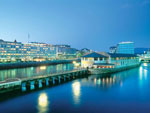Several years ago the house under No.6 on Malaya Dmitrovka street celebrated its centenary. Designed by the architect Illarion Ivanov-Schitz in 1907 it housed Merchant club and saw theatre performances, music and poetry evenings that drew aristocrats, industrialists, philanthropists and cultural figures. Ten years later, during the revolution, it served as ‘anarchy house’, and then Communistic university named after Sverdlov. In 1927 it sheltered Theatre for Working Youth’s Theatre (TRAM), a primogenitor of Lenkom Theatre.
TRAM’s iIdeology positioned it not as a theatre but rather as a tribune of propagandists of socialism, but the people standing at sources of new theatre, did not refuse from bases of classical theatre. Such outstanding figures as Mikhail Bulgakov, Isaak Dunaevsky, Nikolay Batalov and member artists from Kykriniksy creative union were among them. Couple of years after a birth of new theatre, it saw Pushkin, Gorky and Ostrovsky performances.
On 20 February 1938 the theatre got its new name Moscow State Theatre named after Lenin’s Komsomol, or Lenkom for short. Since then it has matured from the theatre of working youth into the contemporary professional theatre. Now actors began to devote themselves entirely to performing instead of coming to studio after the full working day. Ivan Bersenev who headed young theatre played an enormous role in Lenkom’s development. Bersenev led professional actors from the dispersed studio of MKhAT-2, and work on creation of brilliant team began.
Due to Bersenev’s strong will, it took short time for Lenkom to become one of leading theatres in the country. Before the beginning of the Great World War, the theatre started its cooperation with Konstantin Simonov who became its leading dramatist. In 1951 Ivan Nikolaevich Bersenev died, having left the theatre without its ‘father’. After all, this person headed Lenkom in the most difficult years of war and Stalin reprisals.
The new stage in theatre development began only later twelve years afterwards, in 1963, with Anatoliy Efros accession to the leadership He not only introduced new trends in Lenkom, but also led the stellar cast of brilliant actors of that time. However, three years of his management incurred displeasure at the Department for Culture, and Efros was removed from the post of the theatre director, followed by many actors.
The year 1973 brought new changes – the theatre was headed by Rafik Ekimyan who tried to open new horizons for Lenkom. It was when the theatre hosted the performance Avtograd 21 staged by young Mark Zakharov. This bright work has marked Lenkom’s revival as one of leading theatres of Moscow. The performance was followed by Til that confirmed hopes of all admirers of a theatre art.
Til was on theatre’s poster for 14 years, but the rock opera Yunona and Avos’ became Lenkom’s most known performance, along with the rock opera The Star and Death of Joaquin Murety .Together with it there was also a rock opera «the Star and Death of Joaquin Murety, the Chilean robber meanly killed in California on July, 25th, 1853». By the way, the play Yunona and Avos’ celebrated its 30-year anniversary and is still listed in the theatre’s repertoire with inbariable success!







